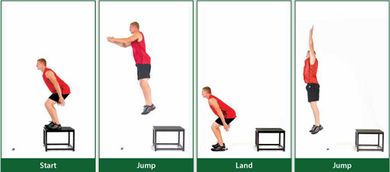Landing Error Scoring System ( LESS): Difference between revisions
(link) |
(link) |
||
| Line 37: | Line 37: | ||
== Links == | == Links == | ||
* https://blog.nasm.org/sports-performance/modified-landing-error-scoring-system-less-acl-injury | * https://blog.nasm.org/sports-performance/modified-landing-error-scoring-system-less-acl-injury | ||
* <code><nowiki>{{#ev: | * <code><nowiki>{{#ev:youtube|</nowiki>[https://www.youtube.com/watch?v=m1PbTJZrr0w&feature=youtu.be m1PbTJZrr0w]<nowiki>}}</nowiki></code> | ||
== References == | == References == | ||
<references /> | <references /> | ||
Revision as of 22:31, 19 February 2020
Original Editor - Your name will be added here if you created the original content for this page.
Top Contributors - Aastha Chowhan
Objective[edit | edit source]
The landing Error scoring System (LESS) is an inexpensive clinical tool used to asses the jump-landing biomechanics. It is used to identify the risk of non-contact injuries during jumping and landing movements. It assesses 9 landing concepts and has 17 questions which are scored out of 19 points.
Intended Population[edit | edit source]
The LESS is used to identify the risk of non-contact injuries in athletes especially involved in sports with a lot of jumping and landing. It is an useful screening tool to identify 'at-risk' athletes and then direct them towards the appropriate training programs. The LESS is also used to assist in deciding return to sport for patients that have undergone anterior cruciate ligament reconstruction (ACLR) surgery (R).
Method of Use[edit | edit source]
- Materials required -
- 12 inch platform
- Target line (At a distance of half the subjects height)
- 2 cameras at 1 meter height (At 10 feet in front of the landing area and at 10 feet to the right of the landing area)
- LESS scale
- Precautions - Make sure that the surface is not affected by wet or slippery conditions
- Procedure -
- Athlete is provided a demonstration prior to their assessment
- The athlete is instructed to jump forward from the box with both feet
- Both feet should make contact beyond the target line
- After contact, jump right back up to maximal height and land again on both feet
- This is repeated for three trials
- The video of the jumps is taken from both the cameras in front and at the side
- Interpretation ( refer to links for the performance sheet)
- The feet, ankle, knees, hip, trunk, shoulder, neck and head posture is assessed through the video
- It is a 19-point continuous scale. According to the performance sheet, the questions 1-15 are Yes/No questions that are rated as 0 or 1. The questions 16 and 17 are rated as 0,1 and 2 depending on the joint displacement and overall performance respectively
- A maximal score of 19 can be reached for exceptionally poor performances and a score of <5 is considered to be good i.e the athlete is considered to be at low risk
Evidence[edit | edit source]
The LESS scores demonstrate good-to-excellent intra-rater , inter-rater and intersession reliability . The validity of the overall LESS score against 3-dimensional jump-landing biomechanics was good. The validity of LESS items versus 3-dimensional motion capture (gold-standard) data was moderate-to-excellent for most of the items that address the key risk factors for anterior cruciate ligament (ACL) injury. (R)
Links[edit | edit source]
- https://blog.nasm.org/sports-performance/modified-landing-error-scoring-system-less-acl-injury
{{#ev:youtube|m1PbTJZrr0w}}







